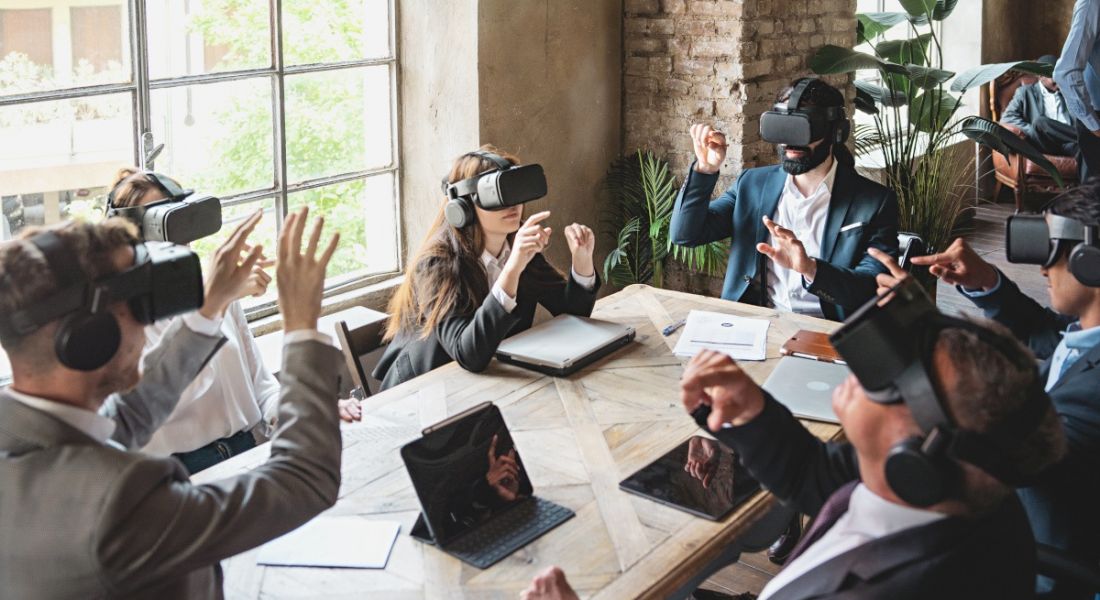The metaverse seems more about entertainment than about helping workplaces foster tangible connections and do work, says Frameable’s Adam Riggs.
If your boss has ever asked you to don a VR headset and join a virtual meeting taking place in some kind of strange 3D office where your colleagues appear like cartoon avatars – commiserations, you’ve been sucked into the monster known as ‘The Metaverse’.
Most of us know how the metaverse hype started. It began in 2021 when Mark Zuckerberg announced Facebook was going to rebrand itself as Meta in a bid to focus on AR and VR technologies.
Augmented reality and virtual reality tech can be fun; it enables gamers to have enhanced experiences from their couches. It’s also useful for adding a futuristic element to art exhibitions and it is even used by the Leinster rugby team to boost fan engagement.
But what about work? Zuckerberg wants the metaverse to function as a sort of catch-all space for people to live in – a kind of tech utopia in which we are all avatars. While that might work for gamers, the same principles shouldn’t be applied to workers. Each group has different needs, for one thing.
Putting on a headset to join a game in your downtime might sound like fun but would the novelty be the same if we had to wear one every Monday morning for a discussion about KPIs?
Gimmick or good thing?
It is no surprise that while some companies have jumped on the metaverse trend, others are much less enthusiastic.
Its proponents say the metaverse is good for onboarding, recruitment and meetings – particularly for distributed workforces.
But many think it’s a gimmick. One of these sceptics is Adam Riggs, CEO of Frameable, a company that has designed virtual workspaces for the likes of Amazon, HubSpot, Uber and Airbnb.
Granted, it is in Riggs’ interest to be sceptical of the metaverse given his own company is selling a product that competes with it, but his critique of what the metaverse represents for workers is nonetheless valid.
Riggs makes it clear to SiliconRepublic.com that he is not against the metaverse, but he has reservations about how it is being deployed in professional contexts.
Frameable CEO Adam Riggs. Image: Frameable
For starters, there’s the hardware aspect. Headsets are not cheap, and not every worker can afford to buy one.
“It just feels a bit too much like technology for technology’s sake. It’s not really clear what the problem is that it’s solving.”
He thinks using headsets to enhance connectivity for distributed workforces is misguided, instead VR and AR should be a kind of “virtual corollary” to the physical space a worker is in – no matter where they are, they should be able to easily meet with colleagues.
“I think that the problem with the current way that distributed work unfolds for most people, is that it’s much too deliberate.
“It requires too much typing and too much scheduling to have the meaningful interactions and the reality of an office is that an office is not a meeting,” he argues.
“It’s not just a set of meetings that are all happening at once. An office is a place where a full spectrum of interaction types take place, scheduled and unscheduled, small and large.
“And if you want to build a virtual version of that, you need to really pay attention to how those interactions come about and how they unfold and how people feel when they’re unfolding and what leads to the next thing … there’s a lot of things you need to pay attention to in order to build a virtual version of that.”
Too much metaverse too soon
Riggs’ view is that the metaverse in its current form is failing to meet ordinary workers’ practical requirements.
When SiliconRepublic.com calls him at his US location, he points out that we’re managing to hold a virtual meeting without wearing headsets.
“Plus, for people who wear glasses, I think the jury is still very much out on if it’s something that can work well for extended periods of time.”
Riggs knows his audience; I’m wearing glasses, as is he. It’s likely that we would both find headsets rather uncomfortable.
Next, he asks a rhetorical question: how many of the companies claiming they work in the metaverse every day actually are?
Riggs is unconvinced that they’re not merely hopping on a bandwagon, releasing news of how the metaverse has benefitted staff interaction. If you look closer, he said, it could just be a case of a company using – and then losing – the metaverse and its clunky headsets.
He thinks using the metaverse to liven up the occasional sales call is reasonable, but when it comes to achieving “the real goals” there are easier ways to do that than telling employees to “wear this headset for eight hours – or I don’t know – whatever the end state is that they have in mind.”
His distrust of the metaverse and its advocates comes down to the fact that he is not sure what its priorities are.
The metaverse is entertaining, but…
“Entertainment driven interactions are one thing and I think entertainment is fine. But what’s currently happening feels like a lot more connected to entertainment goals than it does to how work is done.”
Image: © supamotion/Stock.adobe.com
Where workers are concerned, the metaverse is currently being sold as a tool to help distributed teams feel more connected. (There’s nothing to make you feel more professional than logging on to your computer, wearing a headset, and seeing your virtual self interact with fellow colleagues who, like you, appear as cartoons.)
Riggs isn’t advocating a specific working model, such as remote or in-person. “We’re not proselytising that everyone should be remote all the time working from a boat or whatever. That’s not our view. Our view is that larger companies are going to always have a mix of in-person work and distributed work.”
“They’re going to have real estate investments, for the most part, that they’re trying to right-size and manage. They have environmental footprints that they’re trying to manage – and distributed work is a part of the solution set going into the future indefinitely.”
Will people argue for a return to offices full-time if employers start mandating meetings in the metaverse?
“No,” says Riggs, simply. “They’re going to find another company that doesn’t require that.”
10 things you need to know direct to your inbox every weekday. Sign up for the Daily Brief, Silicon Republic’s digest of essential sci-tech news.




